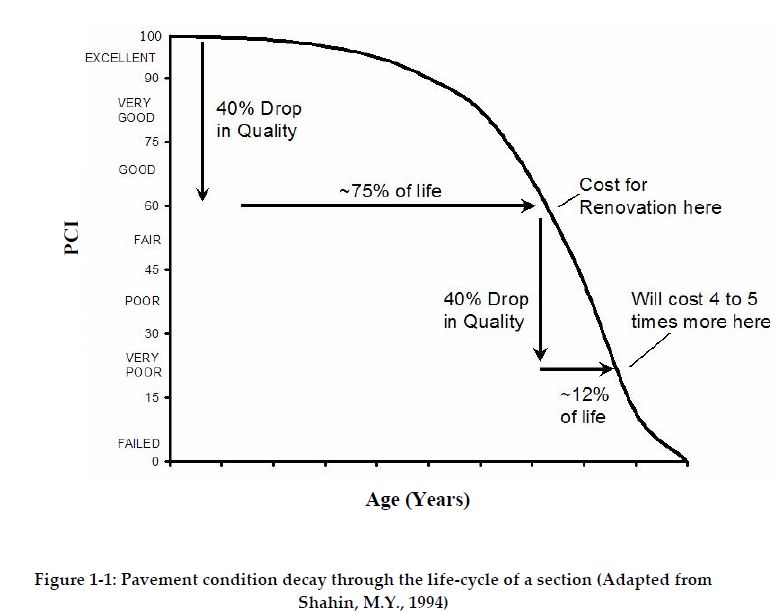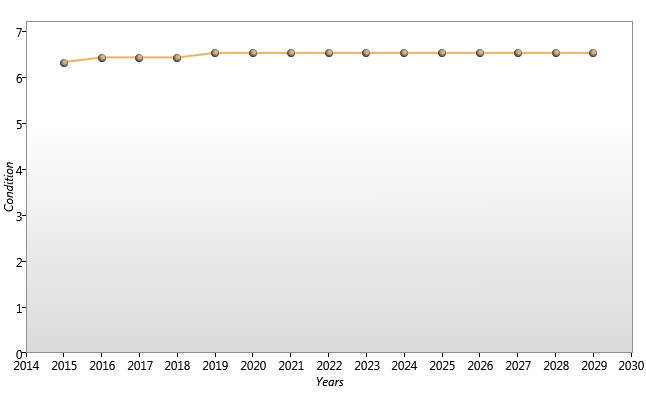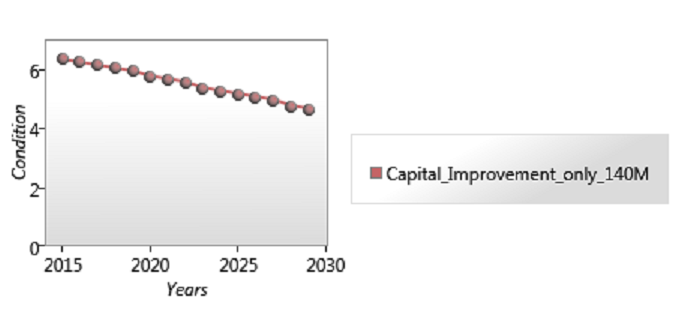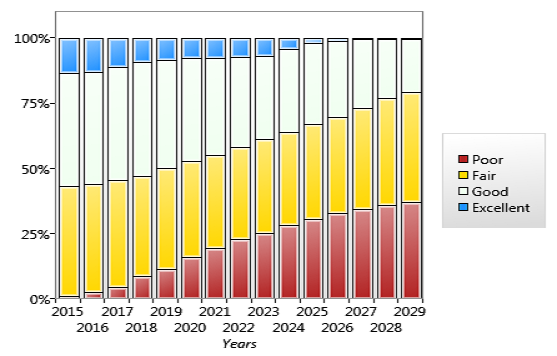Prepared by Vivek Khanna, KSA Engineering
Introduction
The highway infrastructure of the United States consumes 17 percent of its Gross National Product (FHWA, 2006) and has been created over the years at a tremendous cost. Forster (2004) and the Federal Highway Administration (FHWA, 2007) estimate the value of this national transportation infrastructure at $1.75 trillion. The interstate highway system is now more than five decades old. With this aging, the emphasis of the transportation community has shifted from building new infrastructure assets to maintaining and improving the existing assets. FHWA’s online resource center (2007) claims that the total annual capital outlay to preserve and improve the highway system is more than $139 billion.
There has been a nearly 45% increase in total annual expenditures on highways by Federal, State, and local governments from 1997 to 2004 (FHWA, 2006). In 2004 the total expenditures including funds expended for debt retirement, administration, highway patrol, physical maintenance, and capital expenditures amounted to $147.5 billion. Capital expenditures alone on highways rose 45.2%, from $48.4 billion in 1997 to $70.3 billion in 2004 (FHWA, 2006). Resurfacing, rehabilitation, or reconstruction of existing highways and bridges, consumed 51.8% of the total capital budget in 2004. The net effect of the increase in capital investment and the changed focus of improvement efforts has resulted in a 58% increase in spending on highway and bridge rehabilitation ($23.0 billion in 1997 to $36.4 billion in 2004). Investment in construction of new roads and bridges and the widening of existing roads attracted lower funding during this period, rising only 28% from $21.5 billion in 1997 to $27.5 billion in 2004 (FHWA, 2006).
Vast sums of money are therefore spent every year towards the maintenance, rehabilitation (MR) and enhancement of this transportation infrastructure that is vital to the economic health of the nation. Despite the healthy increases in governmental spending on highways, the resources deployed to maintain conditions and performance has increased only marginally in current dollars and has actually declined in terms of real dollars. Added to this, escalating global energy prices are fueling large increases in construction costs. It is therefore important to develop tools to aid administrators faced with ever shrinking budgets and greater accountability, in effective utilization of resources to maximize pavement network serviceability.
Pavement management systems (PMS) provide a systems approach to pavement maintenance management. PMS’s use sophisticated decision making algorithms to assist in the development of prioritized capital improvement programs (CIP) that lead to optimized pavement condition and maximize network serviceability within the imposed budgetary constraints.
The General Accounting Office (GAO, 1998) in its review of current and future levels of Airport Improvement Program (AIP) funding had this to say –
“The National Priority System, FAA’s primary method for determining which AIP grant applications from individual airports should be funded, establishes a priority rating on the basis of factors such as the purpose and type of the project. Runway rehabilitation projects fare well in this system and are typically funded ahead of most other types of projects. Most applications for such projects received funding in fiscal year 1997, according to FAA officials. However, local FAA officials said that they forward only those applications they are relatively certain will be funded. FAA’s priority system is not well equipped to determine which proposed rehabilitation projects will deliver the best return for the dollars spent. Waiting to rehabilitate a runway until the pavement has seriously deteriorated can mean that rehabilitation will cost 2 to 3 times as much as it would have if rehabilitation had occurred earlier. The key to identifying the best time to conduct rehabilitation is having comprehensive knowledge of pavement conditions. Currently, fewer than half of the airports in the national system have information systems that will provide this knowledge. Furthermore, when allocating Airport Improvement (AIP) funds, FAA does not evaluate the cost-effectiveness of the rehabilitation projects it approves”.
In its report GAO (1998) recommended that the Federal Aviation Administration (FAA) require all airports in the national airport system (NAS) to submit index ratings on pavement condition on a regular basis and use this information to create a database on pavement conditions for evaluating the cost-effectiveness of project applications and forecasting anticipated pavement needs.
Historical view of PMS development
The concept of pavement management as a tool for maximizing utilization/serviceability of a network of pavements with the deployment of optimal resources dates to the 1960s. Some engineers consider the American Association of State Highway Officials (AASHO) road tests (1956 – 1960) as being the origins of the systems approach to pavement maintenance. As a result of the tests, it was postulated that pavement performance could be described independent of pavement type. In 1966, a study was initiated to arrive at an understanding of the AASHO road tests. Expanding on this study, Hudson (1968) started work on a systems approach to pavement design and maintenance. Wilkins (1968) led Canadian efforts at developing a systems approach to pavement management. Scrivner (1968) of the Texas transportation Institute presented a systems approach to flexible pavement design.
By the late 1960s, the term “pavement management system (PMS)” had been coined and was in use to describe a systems approach to pavement design and maintenance. One of the earliest attempts to translate the systems concept into a working schema was a result of Texas Department of Transportation’s (TxDOT) Project 123 (Hudson, 1970). This study pioneered development of many of the techniques of pavement management. The National Cooperative Highway Research Program’s (NCHRP) project 1-10 (Hudson, 1973) presented a working methodology for pavement management. The US Army Construction Engineering Research Laboratories (USACERL) with funding from the FAA, American Public Works Association (APWA), Federal Highway Administration (FHWA), US Air Force Engineering and Services Center (AFESC), US Navy and US Army Corps of Engineers (USACOE) released the first version of USACERL’s PMS in 1981.
The PMS concept demonstrated the need as well as the benefit of a systems approach to not only pavement design but to the construction and periodic maintenance of pavements as well. Figure 1 reiterates the rationale behind pavement management. It explains that the premise of a systems approach to pavement management is that “for every dollar spent on managed pavements, agencies can save between three to six dollars in reduced pavement maintenance costs”.
The FHWA-University of Texas-HRB conference on structural design of asphalt pavement systems in 1970 made it clear that PMSs were here to stay. The American Association of State Highway and Transportation Officials (AASHTO) issued their guidelines for pavement management systems in 1985. These guidelines contained minimal suggestions for developing and implementing a PMS. AASHTO (1990) later issued more detailed guidelines in 1990. Then in 2001, AASHTO (2001) issued comprehensive, guidelines identifying the state-of-practice in pavement management. These guidelines provide a good PMS implementation procedure and describe the typical components of a good PMS.
Zimmerman et al. (2000) summarize that PMSs are expected to form a vital part of decision making for managing and maintaining the transportation infrastructure. Pavement managers must address their transportation needs in this era of soaring construction costs and shrinking budgets while at the same time be held to ever greater scrutiny in their efficiency in the expenditure of taxpayer money. As a result, the importance of infrastructure management systems (IMS) to assist with effective allocation of these resources to manage infrastructure assets becomes more critical than ever. The systems approach has created a realization in the stakeholders that the challenge of managing and maintaining existing transportation infrastructure under today’s environment is more difficult than the design and construction of the initial system, when there was less scrutiny of public expenditures.
As per Thomas (1995), infrastructure in the United States and the world is aging. Pavement engineers and transportation managers are increasingly aware of the need to assess the condition of this vital asset. However, finite budgets limit the replacement of assets. It is therefore imperative to accurately asses the condition of and damage to transportation infrastructure.
For more information, please contact Dr. Vivek Khanna at: vkhanna@ksaeng.com
References:
- AASHTO, “Pavement management guide”, Washington D.C., 2001.
- FHWA, “Status of the Nation’s Highways, Bridges, and Transit: 2006 Conditions and Performance Report”, http://www.fhwa.dot.gov/policy/2006cpr/hilights.htm, 2006.
- FHWA, “Online resource center – Asset Management Guide”, http://www.fhwa.dot.gov/resourcecenter/teams/finance/fin_1amg.cfm, 2007.
- General Accounting Office, “Keeping Nation’s Airport Pavements in Good Condition may require substantially higher Spending”, GAO/RCED-98-226, Washington D.C., 1998.
- Hudson, W. R., Finn, F. N., McCullough B.F., Nair, K. and B.A. Vallerga, “Systems Approach to Pavement Systems Formulation, Performance Definition and Materials Characterization”, Final Report, NCHRP Project 1-10, Materials Research and Development, Inc., March 1968.
- Hudson, W. R., and B. F. McCullough, “Systems Approach Applied to Pavement Design and Research, Research Report 123-1”, Center for Transportation Research, The University of Texas at Austin, March 1970.
- Hudson, W. R., and McCullough, B. F., “Flexible pavement design and management, National Cooperative Highway Research Program Report”, No. 139, 1973.
- Scrivner, F.H., Moore, W.M., and McFarland, W.F., “A systems approach to the flexible pavement design problem”, Research Report 32-11, Texas transportation Institute, Texas A&M University, 1968.
- Shahin, M. Y., “Pavement management for airports, roads, and parking lots”, Kluwer Academic, Dordrecht, The Netherlands, 1994.
- Thomas, G., “Overview of nondestructive techologies”, Proceedings of the international society for optical engineering, Volume 2457, 5–9, 1995.
- Wilkins, E.B., “Outline of a Proposed Management System for the CGRA Pavement Design and Evaluation Committee”, Proceedings Canada Good Roads Association, Ottawa, 1968.
- Zimmerman, K.A., Botelho, F. and Clark, D., “Taking Pavement Management into the Next Millennium, Transportation in the New Millennium: State of the Art and Future Directions”, Perspectives from Transportation Research Board Standing Committees, Transportation Research Board, 2000.





